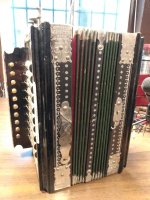Hello, I am restoring a very old "Imperial Accordeon" melodeon. It has 3 stops. The ones on either end are an octave apart. What is highly unusual is the the middle stop activates a set of reeds usually a 6th, but sometimes a 5th above the lower reed. I have a Hohner Imperator with a quint set of reeds (a 5th above the piccolo reeds), and have worked on Tiger accordions with the quint a 5th above the clarinet reed, but have never come across an accordion with this feature. I'd be curious to know if anyone has seen this before.


